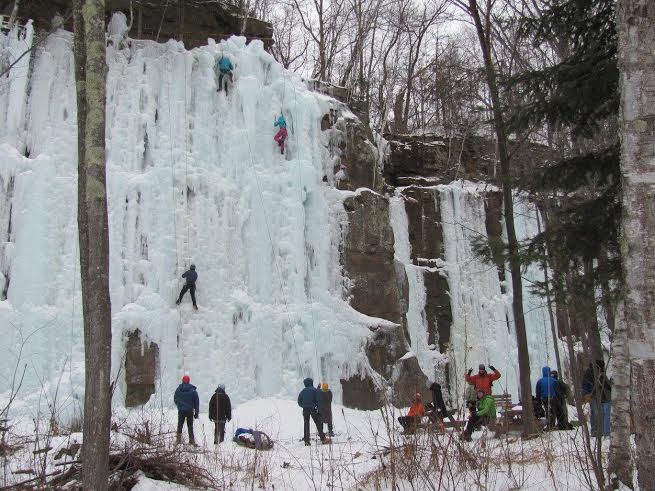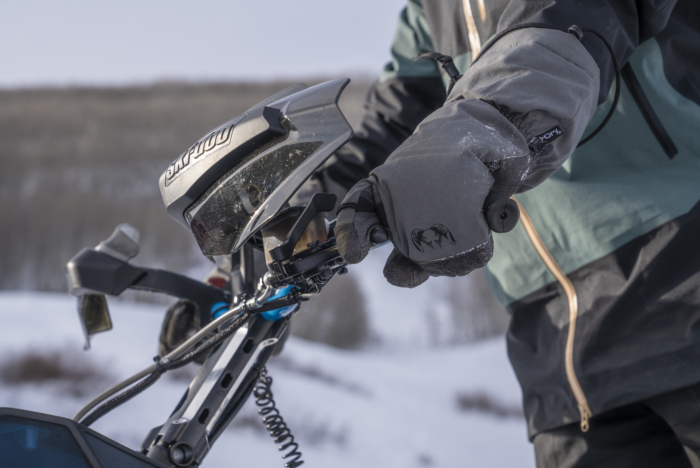
At an old quarry in Sandstone, Minn., a shower head sprays water over a cliff edge. It mists then crystalizes in the winter air, the water changing to form an otherworldly playground for climbers equipped with axes and crampons on their boots.
The act of “farming” ice is careful work. But a dedicated crew of climbers has done it here for years.
It’s a recipe applied in locations around North America, most famously in a small town in Colorado, where the Ouray Ice Park boasts more than 200 farmed ice-climbing routes.
At Minnesota’s Sandstone Ice Park, volunteers each fall assemble pipes, hoses, valves, and shower heads in order to sculpt climbing routes. As temps drop in November and December, the water is turned on, and over the course of just a few hours substantial ice forms on the quarry walls.

After a few days, huge pillars of ice appear. The tallest routes are 70+ feet at Sandstone, and sometimes up to 10 feet thick. These vertical floes are picked, kicked, and climbed by hundreds of area ice junkies each winter.
But it’s not as simple as just turning on a hose and aiming it over the edge. The intricacies of ice farming include working in a difficult cliff-side environment, often on rappel. Ice farmers must set up irrigation-grade pipes along the cliff edge, which requires fastening them to the rock face or tethering them to trees — a multi-person endeavor.

The pipes must slope downward from the water intake — any sags will accumulate water and freeze. Frozen pipes or hoses will stop ice making/farming for the season. Slush and ice can clog pipelines and create pressure spikes that can break connections upstream — it’s all about keeping the water flowing.
Getting the water to the cliff edge at Sandstone necessitates about 600 yards of two-inch hose. It is stretched from a water source to the pipes fastened to the cliff edge.
Several smaller sections of plastic tubing stem out along the main trunk of pipe and lay on the top of the cliff. On the end of each is a regular hardware store shower head, which can freeze shut and need the flame from a propane torch to get flowing again.

Shower head placement is key to making climbable ice. If it is placed so that water shoots into space, the result will be “chandelier ice” that is airy, loose and creates a lot of shattering, and it will fall on the climber attempting to get a solid stick with an ice tool.
Instead, ice farmers set the shower heads back a foot or two from the edge, allowing the water to flow over the face of the rock, mimicking the flow a small stream or creek would create.
In autumn, the system is set up and tested. Once the temperature is favorable it is turned on and left to run for several days. Returning after this time to see the results of the hard work and experimentation is always rewarding.

People have been climbing at Sandstone’s quarry for decades, including rock climbing in the summer and a couple of natural-forming ice routes in the winter. In 2004, climbers worked with the local fire department to get water over the cliffs. They pumped water from a small pond on the ground level of the park to the top of the quarry.
In 2010, with the city’s blessing and initial financial support, a water source was installed at the top of the cliff. It’s now funded by donations from climbers and by the Minnesota Climber’s Association fundraiser at the Sandstone Ice Festival, an annual event.
Beyond Sandstone, ice farming is seen around the Midwest. It is a geological fact that the central part of the United States is vertically-challenged. Climbers get creative in constructing their own faux mountains.

In 2003, ice farmers went to work on a quarry near Green Bay, Wis., dubbed “The Ice Pit.” Climbers used natural seepage as well as pumped water from a source at the bottom of the quarry to create challenging routes 100 feet or more in height.
The Ice Pit was run by a nonprofit club and operated from 2003 to 2011.

The grain silos of Iowa and Illinois that dot the Great Plains are fair game for farming. A few resourceful climbers have coated the cylindrical towers with an icy glaze.
Camps around the Midwest feature ice-climbing structures. Water dripped off the top of wooden or metal structures forms easily into climbable ice.
In Minnesota and Wisconsin, along the bluffs of a Mississippi River tributary, some adventurous homeowners have been able to make short ascendable ice on backyard cliffs with their home garden hose.
As the sport of climbing has grown, so has ice farming. It’s a unique manmade alternative that can net natural climbs by a simple act of combining flowing water, gravity, and subfreezing air.







